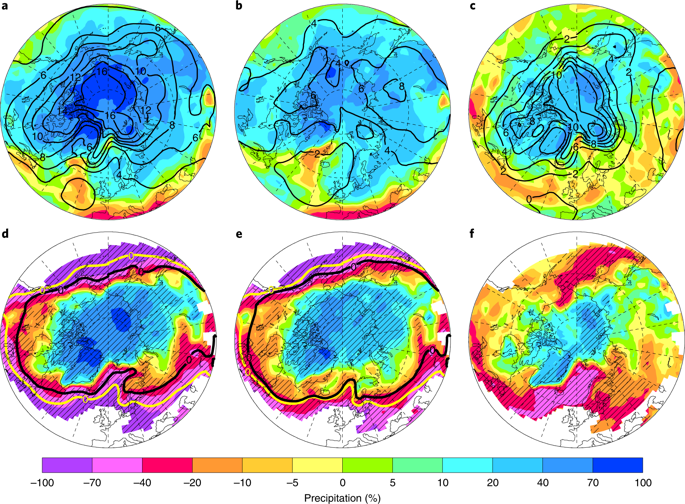Nature Climate Change ( IF 29.6 ) Pub Date : 2020-02-10 , DOI: 10.1038/s41558-020-0694-3 Aiguo Dai , Mirong Song

|
Observations1,2,3 and model simulations3,4 show enhanced warming in the Arctic under increasing greenhouse gases, a phenomenon known as the Arctic amplification (AA)5, that is likely caused by sea-ice loss1,3. AA reduces meridional temperature gradients linked to circulation, thus mid-latitude weather and climate changes have been attributed to AA, often on the basis of regression analysis and atmospheric simulations6,7,8,9,10,11,12,13,14,15,16,17,18,19. However, other modelling studies20,21,22 show only a weak link. This inconsistency may result from deficiencies in separating the effects of AA from those of natural variability or background warming. Here, using coupled model simulations with and without AA, we show that cold-season precipitation, snowfall and circulation changes over northern mid-latitudes come mostly from background warming. AA and sea-ice loss increase precipitation and snowfall above ~60° N and reduce meridional temperature gradients above ~45° N in the lower–mid troposphere. However, minimal impact on the mean climate is seen below ~60° N, with weak reduction in zonal wind over 50°–70° N and 150–700 hPa, mainly over the North Atlantic and northern central Asia. These results suggest that the climatic impacts of AA are probably small outside the high latitudes, thus caution is needed in attributing mid-latitude changes to AA and sea-ice loss on the basis of statistical analyses that cannot distinguish the impact of AA from other correlated changes.
中文翻译:

北极放大对中纬度气候影响不大
观测1,2,3和模型模拟3,4表明,在温室气体增加的情况下,北极变暖加剧,这种现象被称为北极放大 (AA) 5,这很可能是由海冰流失1,3引起的。AA 减少了与环流相关的经向温度梯度,因此中纬度天气和气候变化归因于 AA,通常基于回归分析和大气模拟6,7,8,9,10,11,12,13,14 ,15,16,17,18,19。然而,其他建模研究20,21,22只显示一个薄弱环节。这种不一致可能是由于将 AA 的影响与自然变率或背景变暖的影响区分开来的缺陷造成的。在这里,使用有和没有 AA 的耦合模型模拟,我们表明,中纬度北部的冷季降水、降雪和环流变化主要来自背景变暖。AA 和海冰损失增加了约 60° N 以上的降水和降雪,并减少了对流层中下层约 45° N 以上的经向温度梯度。然而,在约 60° N 以下,对平均气候的影响最小,纬向风在 50°–70° N 和 150–700 hPa 范围内减弱,主要在北大西洋和中亚北部。这些结果表明AA的气候影响在高纬度以外可能很小,











































 京公网安备 11010802027423号
京公网安备 11010802027423号